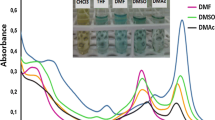Abstract
Oxidation catalysis is one approach used to improve the performance of hydrogen peroxide in laundry bleach applications. We introduce herein a new class of bleach catalysts based on the ligand 2,2′∶6′,2″ terpyridine. A set of manganese complexes of substituted terpyridines was investigated with respect to their physicochemical properties and bleach performance. Introduction of electron-donating hydroxy and amine substituents in the 4-position of the individual pyridine rings improves the bleach performance in model experiments with morin (2′,3,4′,5,7-pentahydroxyflavone) in solution as well as on tea-stained cotton fabrics. All the catalysts show excellent bleach performance at 40 and 25°C under European washing conditions. Performance is superior to that of the activator tetraacetyl ethylenediamine (TAED) but depends critically on the substitution pattern. Dye damage caused by the catalysts is similar to that of TAED, proving that catalytic bleach systems with high performance and low damage are indeed feasible. Model experiments revealed that the complexes are highly stable under aqueous alkaline conditions in the presence of hydrogen peroxide. The optimal pH for catalytic activity is about 10. For a catalyst to have a high bleach performance, it must possess a sufficiently low activity to catalyze disproportionation of hydrogen peroxide, which is a major side reaction of catalytic bleach with manganese complexes. All the catalysts showed a similar affinity for the cotton fabric, suggesting that differences in bleach activity of complexes are not caused by differences in the fabric affinity.
Similar content being viewed by others
Abbreviations
- ICP-OES:
-
inductively coupled plasma-optical emission spectroscopy
- morin:
-
2′,3,4′,5,7-pentahydroxyflavone
- SNOBS:
-
sodium nonanoyloxybenzene sulfonate
- TAED:
-
tetraacetyl ethylenediamine
- terpy:
-
2,2′∶6′,2″-terpyridine
- TMTACN:
-
1,4,7-trimethyl-1,4,7-triazacyclononane
- Trolox C:
-
6-hydroxy-2,5,7,8-tetramethylchroman-2-carboxylic acid
- UV/vis:
-
ultraviolet/visible
References
Milne, N.J., Oxygen Bleaching Systems in Domestic Laundry, J. Surfact. Deterg. 1:253 (1998).
Collins, T.J., Designing Ligands for Oxidizing Complexes, Acc. Chem. Res. 27:279 (1994).
Dannacher, J.J., F. Bachmann, M.J. Dubs, M.F. Hazenkamp, G. Richter, and G. Schlingloff, Catalytic Bleach. Panacea or Fata Morgana, in Proceedings of the 5th World Surfactants Congress, Vol. 2, Firenze, Italy, 2000, p. 1237.
Hage, R., J.E. Iburg, J. Kerschner, J.H. Koek, E.L.M. Lempers, R.J. Martens, U.S. Racherla, S.W. Russell, T. Swarthoff, M.R.P. van Vliet, J.B. Warnaar, L. van der Wolf, and B. Krijnen, Efficient Manganese Catalysts for Low-Temperature Bleaching, Nature 369:637 (1994).
Hazenkamp, M.F., F. Bachmann, J.J. Dannacher, and G. Schlingloff, Oxidation Catalysts for Dye Transfer Inhibition, Tenside Surf. Det. 36:393 (1999).
Reinhardt, G., Bleichkatalysatoren—Nutzen und Risiko, in Conference Proceedings of the 48th SEPAWA [Confederation of Soap, Perfume, and Detergent Experts] Congress, edited by K. Henning, Bad Dürkheim, Germany, 2001, p. 62.
Bachmann, F., J.J. Dannacher, B. Freiermuth, M. Studer, and J. Kelemen, Vat Dye Sensitised Fibre Damage and Dye Fading by Catalytic and Activated Peroxide Bleaching, J. Soc. Dyers Colour. 116:108 (2000).
Schlingloff, G., T. Wieprecht, F. Bachmann, J. Dannacher, M.J. Dubs, M. Hazenkamp, G. Richter, B. Schmidt, A. Schneider, and P. Weingartner, WO patent 0288289 (2002).
Kubelka, P., and F. Munk, Ein Beitrag zur Optik der Farbanstriche, Z. Tech. Phys. 11:593 (1931).
Blum, H., B. Mayer, and U. Pegelow, German Patent 19620267 (1996).
Jovanovic, S.V., S. Steenken, M. Tosic, B. Marjanovic, and M.G. Simic, Flavonoids as Antioxidants, J. Am. Chem. Soc. 116:4846 (1994).
Pecoraro, V.L., and W.Y. Hsieh, The Use of Model Complexes to Elucidate the Structure and Function of Manganese Redox Enzymes, in Manganese and Its Role in Biological Systems, edited by A. Sigel and H. Sigel, Marcel Dekker, New York, 2000, p. 429.
Phillips, D., J. Scotney, and D. Kenyon, Application of the Proposed ISO 105-C09 Single Cycle Test to Predict the Oxidative-Bleach Colour Fading of Dyed Cotton Fabrics to Repeated Laundering with a Detergent Base Containing Different Bleach and Bleach Activator Systems, Color. Technol. 117:247 (2001).
Gilbert, B.C., N.W.J. Kamp, S. Lindsay, and J. Oakes, EPR Evidence for One-Electron Oxidation of Phenols by a Dimeric Manganese (IV/IV) Triazacyclononane Complex in the Presence and Absence of Hydrogen Peroxide, J. Chem. Soc. Perkin Trans 2:2161 (1997).
Moe, K.D., With Bleach Detergents: How They Work, Textile Chemist and Colorist & American Dyestuff Reporter 32:79 (2000).
Author information
Authors and Affiliations
Corresponding author
About this article
Cite this article
Wieprecht, T., Heinz, U., Xia, J. et al. Terpyridine-manganese complexes: A new class of bleach catalysts for detergent applications. J Surfact Deterg 7, 59–66 (2004). https://doi.org/10.1007/s11743-004-0289-7
Received:
Accepted:
Issue Date:
DOI: https://doi.org/10.1007/s11743-004-0289-7




